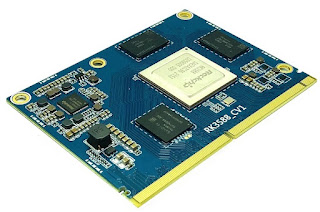For years, the makers of the Banana Pi series of small
computers have been producing Raspberry Pi rivals, the newest of which is a new
computer-on-a-module with an octa-core Rockchip RK3588 CPU, support for up to
8GB of LPDDR4 memory, and up to 128GB of eMMC storage.
The new Banani Pi card, like the Raspberry Pi Compute
Module, has a CPU, memory, storage, and all of the other essential computer
functions. However, if you want ports, you'll need to attach it to a carrier
board.
At this time, Banana Pi refers to the new module as a
development kit, and says that hardware samples are available upon request, but
the new board isn't for sale yet, and retail pricing hasn't been revealed.
The RK3588 processor, which is the same chip that drives the
Radxa ROCK5 single-board computer, is at the core of the tiny computer. It's an
8nm chip with the following features:
- 4 cores ARM Cortex-A76 CPU
- ARM Mali-G610 MP4 graphics
- 4 x ARM Cortex-A55 CPU cores
A neural processing unit with 6 TOPS of performance, support
for 8K video decoding in H.264 and H.265 codecs, and OpenGL ES 3.2, OpenCL 2.2,
and Vulkan 1.1 graphics are also included in the CPU.
While it may not be as powerful as the newest Qualcomm, MediaTek, or Samsung CPUs, it is Rockchip's most powerful processor to date, and the company's chips have proved popular with open source software-focused products such as Pine64's range of Linux-friendly laptops, tablets, and smartphones.
Banana Pi claims that their new board supports Android 12
and Linux software and can be configured with 2GB, 4GB, or 8GB of RAM and 32GB,
64GB, or 128GB of eMMC storage.
PCIe 3.0, SATA 3.0, and USB 3.1 Type-C interfaces are all supported by the computer module, but you'll need to connect it to a carrier board to use them. A prototype board containing two Ethernet ports, three HDMI connectors, three USB ports, and a microSD card reader, among other connections, is shown in a post on the Banana Pi forum.













